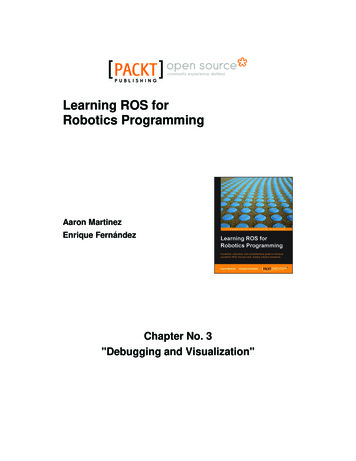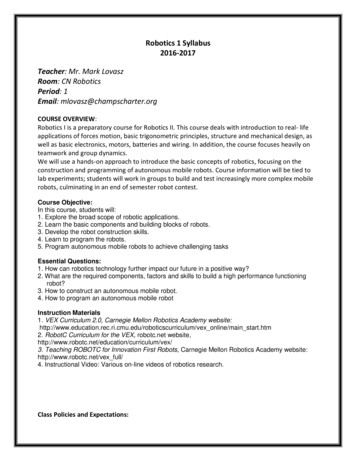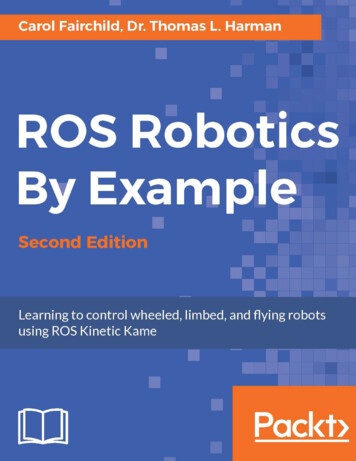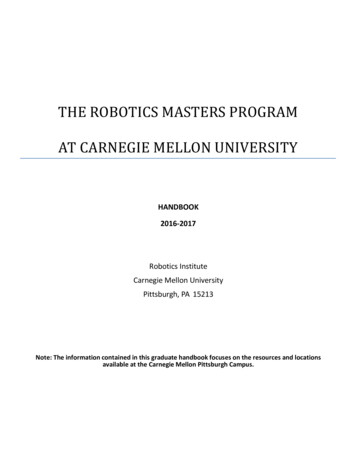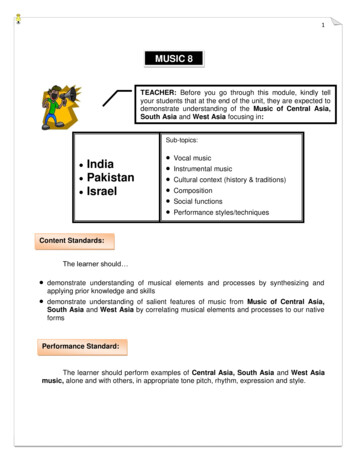
Transcription
RoboticsIn this category the participants asked to design, build and program robots. Currently thereis a huge interest in robotics worldwide. Companies as well as people have a certain interest inrobotics and it is increasing rapidly. To make the new generation more curious and passionateabout robots, several competitions have been held in different countries around the globe.“INFOMATRIX-ASIA” invites the best minds from around the world to compete in this category.In competition there are going to be these subcategories for Robotics: Lego Sumo, Arduino MiniSumo.1. Registration requirements:Participants shouldA) fill information about themselves and send project description file which includescode and information about components of robot (pdf format)B) upload video that shows robot in action on youtube and send link (title consists ofteam name and subcategory) duration min 3 min, max 5 min2. Stage – IIn this stage teams present their robots and compete in the particular subcategory to earnas much points as they can. As explained above there are going to be these subcategories forRobotics: Lego Sumo, Arduino Mini Sumo robots.Make sure to read all rules and specific requirements related to each subcategory in thedocuments. At this stage, participants can take 50% (percentage subject to change) of the totalpoints.3. Stage - IIThe second stage of the competition will be a hackathon. In which participants must solvethe given problem in the fixed amount of time. Participants must prepare and bring by themselveslaptops, software, all components and details depending on the category of Lego Sumo or ArduinoMini Sumo. Participants can use components of their sumo robots. Each team member must bepresent, otherwise the work will not be accepted.The task itself and all information about hackathon: conditions, criterias will be publishedon the website infomatrix.asia on the day the competition starts.An example task for preparation for a hackathon: successful passage of a robot through amaze, mission completion or design task
Figure 1: example of mazeFigure 2: example of missionTask for Lego Sumo category will be based on Lego Mindstorms and task for ArduinoMini Sumo category will based on Arduino.At this stage, participants can take 50% (percentage change) of the total points. These twostages will be added, and the final score will be determined, and the decision will be made on thebasis of the points received.Note: try to bring a full box of details.4. Evaluation of projects and determination of degrees:In the first phase all teams with their robots are going to compete. On the second day allteam members will participate in the Hackathon to show their knowledge in robotics field. Theevaluation process is going to like explained in the main rules and regulation section. Participantswill be given their points based on two phases.IMPORTANT NOTES:1. Participants must bring their all needed equipments for the competitionArduino Mini Sumo and Lego Sumo rules 20201 Robot classesArduino Mini Sumo and Lego Sumo.2 CompetitionThree operators can be registered for every robot. However, only the operator is allowed to guide therobot. All contestants must follow the competition rules, the terms and conditions of winning andparticipate using only self-made autonomous robots at the Dohyo area designated beforehand. Thewinner is announced by the judges.3 Dohyo Jyonai - the match ring area
Match ring areas for Lego sumo and Arduino Mini sumo are same.Figure 2: Match areaClassRing Height Ring Diameter White Border WidthArduino Mini sumo ring2.0-3.0 cm77 cm2.0-4.0 cmLego sumo ring2.0-3.0 cm77 cm2.0-4.0 cm4 Requirements for the robot4.1 Requirements for the robot1. Dimension and weight restrictionsClassArduino Mini SumoLego SumoMass500 g1000 gLength10 cm15 cmWidth10 cm15 cmHeightunlimitedunlimited* The robot may expand after the start of the round, but must stay in one piece.2. Autonomous robots – starting the movementsStarting method: 5-second timer. The timer can be activated by the operator of the robot bypressing a button or via remote control system.3. Autonomous robots – stopping the movementsStopping method: The operator of the robot stops the robot by pressing a button or via remotecontrol system.4. Requirements for blade use
It is not forbidden to use double blades. It is forbidden to use any components that may segregatefrom the robot when it moves or comes into contact with another robot.4.2 Movements of autonomous robotsMovements of autonomous robots should be designed to detect the movements of the opponentand respond/attack accordingly. If there is any doubt in the autonomy of the robot, the refereeshave the right to inspect the control logic of the robot.4.3 Use of remote control devices with autonomous robotsDuring the competition (round), the remote control devices must be placed on a previouslydesignated area. The devices may only be used to stop the robot, when the referee gives acorresponding command. The official infrared remote control device is held by the referee.4.4 Prohibited components of the robot1. Any components that may disturb the operation of the opponent (for example, ashlightsor jamming devices such as IR LEDs intended to saturate the opponents IR sensors).2. Any components that may damage or scratch the surface of Dohyo. An exception is whenthe robots collide.3. It is forbidden to use any liquids, powders and gas as a weapon against the opponent.4. It is not allowed to use any inflammable materials in the robot.5. The robot must not include any throwing devices (for example throwing a net on opponent).6. The robot must not include any parts, which fix it onto the Dohyo (for example, glues,suction cups, etc.). Magnets that improve the grip of the wheels are prohibited.5 Match principles1. The match generally contains three rounds and lasts up to three minutes. The team whoearns two Yuko points (effective points) first during the time of the match will be thewinner. Match time is measured during rounds, not between them.2. If only one Yuko point has been earned by the end of the match time, the winner is theteam who earned it.3. If neither team wins any rounds during the match time, the winner will be announcedaccording to the situation of Yusei (dominance), see paragraph 7.3. If Yusei cannot bedecided or the number of rounds that has been won is the same for both teams, the match
time will be extended by three minutes. If one team earns one or more Yuko points duringthe extended time, then this team will be the winner.4. The contestants have a maximum of 30 seconds between the rounds to maintain their robot.Figure 3:directions inbeginningRobot'sthe6 The organization of competition6.1 Starting the match1. The match starts according to the referee’s signal.2. Before each round and according to the signal of the referee, the contestants place theirrobots simultaneously on the Dohyo. The robots are not allowed to move after they havebeen placed on the Dohyo.3. After the signal of the referee, the operators starts the 5-second timer in the robot andimmediately leave the area of Dohyo Jyonai. The robots may start moving 5 seconds afterthey have received the start command.4. In case the Dohyo area is scratched or becomes dirty, the referees decide whether tocontinue the match on the same Dohyo or replace it.6.2 Ending the match1. The referee gives a signal to end the match and stop the robots. The robot is stopped bythe operators of the robot.2. The match end officially after a corresponding signal from the referee. The participantsmust take their robot from the Dohyo and leave the area of Dohyo Jyonai.6.4 Repeat of round (Tarinaoshi)
The round is repeated in the following situations.1.2.3.4.Both robots are facing each other and their movement is hindered or it does not happen.Both robots fall out of the Dohyo at the same time.Other situations in which it is not possible to determine who has won and lost.If it is not possible to announce the winner after Torinaoshi, the referee may place therobots himself or herself and continue with the match within the allocated time.6.5 Handling the robots between the matchesFor the time between the matches in the same sub-group, the robots must be placed on a tablegiven for it and can be removed from there only for the duration of the match. It is forbidden toleave the competition area with the robot between the matches, except for when a correspondingpermission has been given (e.g. the robot needs xing). The purpose of this requirement is toguarantee the smooth course of the competition.NB! If the robot cannot be found from the designated table at the right time or if the team itself isnot present, the match will result in a loss.7. Yuko (effective) point, Shinitai and Yusei (dominance)7.1 Yuko (effective) point The winner is announced in the following situations.1. If the opponent has been pushed out of the Dohyo (the robot touches the area outside of theDohyo).2. If the opponent falls out of the Dohyo and touches the area outside of the Dohyo.3. In the situation of “Shinitai”.4. In the situation of “Yusei (dominance)”.5. If “Keikoku (warning)” is given twice to the opponent.6. If there is a case of “Hansoku (violation)”.7. If the winner is announced without a match, the winner earns two Yuko points8. (if the winner already has one Yuko point, he or she earns only one more). The existing Yukopoint(s) of the opponent who lost remain effective.7.2 Shinitai“Shintai” situation means that one or several wheels of the robot roll out of the Dohyo and therobot is unable to return to the Dohyo. In this case, the opponent earns one Yuko point.7.3 Yusei (dominance)In a situation of “Yusei” (dominance), the referee may grant a Yuko point to the team accordingto the strategy, movements and skills of the robot.8 Hansoku (violation) and penalty
8.1 Keikoku (warning)A contestant who acts as indicated below gets a “Keikoku” (warning). If the contestant gets twoKeikokus (warnings), the opponent earns one Yuko point.1. If the operator or some item of the operator (for example, remote control) ends up in the areaof Dohyo Jyonai before the round ending signal of the referee.2. If the robot moves before the beginning of the round (movement or changing its shape).3. If the participant violates the requirements for the use of remote control.4. If the robot is replaced after it is placed on the Dohyo.5. If the participant does not comply with the safety requirements.6. In case of any other action that is considered unfair.8.2 Hansoku (violation) In the following situations the opponent or both parties earn oneYuko point.1. If some part falls o from the robot.2. If the robot does not move.3. If both robots move, but do not collide.4. If the robot is on fire or a situation, which resembles that the robot is on fire.5. If the participant wants to end the round.8.3 Hansokumake (defeat due to violation)The participant who violates the following rules, loses the match due to violation.1. If the contestant fails to show up at the designated Dohyo at the beginning of the match or theparticipant exceeds the time given from maintenance, see paragraph 5 Match principles.2. If the contestant sabotages the match. For example, deliberately breaking or deforms the Dohyo.3. If the participant violates the requirements provided for in paragraph 4 Requirements for therobot.4. If the robot does not make autonomous movements.5. If the participant does not comply with the requirements provided for in paragraph 6.1 Safetyrequirements even after “Keikoku” (warning).8.4 Sikkaku (disqualication)In the following cases, the participant will be disqualified – he or she must leave the competitionand is not added to the list of competition results.1. If the participant’s robot does not comply with the requirements provided for in paragraph 4.1Requirements for the robot .2. If the participant behaves in an undignified manner. For example, swears or offends theopponent or the referees.3. If the participant deliberately injures the opponent.9. Suspending the match1. If the participant is injured and the match cannot be continued, the participant may demand thesuspension of the match.
2. In the event of the previously described situation, the referees make necessary arrangements forthe match to be immediately resumed.3. If the arrangements do not enable the match to continue, the opponent wins the competitionwithout a match.
Arduino Mini Sumo and Lego Sumo rules 2020 1 Robot classes Arduino Mini Sumo and Lego Sumo. 2 Competition Three operators can be registered for every robot. However, only the operator is allowed to guide the robot. All contestants must follow the competition rules, the terms and conditions of winning and
